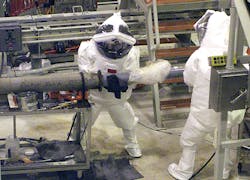Preparing for this conference – deciding on the theme, creating topics, finding speakers, forging partnerships with sponsors – has made for some of the most challenging and creative time I’ve spent in my current position as editor in chief of EHS Today.
Being so immersed in this project has me thinking about transformational leadership and transformational leadership in safety, which is the theme of our conference. There will be many transformational leaders speaking at our conference, and one who will not be speaking. He is the one I want to talk about.
As the president of one of the companies chosen for recognition for America’s Safest Companies 2012, he was slated to be one of our speakers at the Executive Roundtable that leads off the conference on Sept. 11. Unfortunately, he had to drop out. That’s the bad part.
His letter to me, explaining his reason for dropping out reveals so much about the corporate culture at the company that with his permission, I want to share it with you (Spoiler Alert! You are going to know the name one of America's Safest Companies 2012 before we make the official announcement on Sept. 11):
Dear Ms. Smith:
It is with deep regret that I must inform you that I will not be in attendance at the America's Safest Conference. This decision was difficult, especially knowing that we were going to be recognized as one of the safest companies. However, my decision was made in the manner that most are made in this company – with significant input by our workers. Let me explain.
I recently herniated a disk in my lower back. Surgery is possible but given my medical history has some risks to it – so the surgeon recommended eight weeks of physical therapy in an attempt to preclude surgery. I was planning to continue to travel – to this event and to several other items of company business – when one of our workers asked me, quite bluntly, what I was doing. In pretty specific terms, he noted that I was increasing risk – and the likelihood of more significant work absences – by not fully committing to therapy and instead continuing to work and travel as if nothing had changed, squeezing in therapy when I could. Two things struck me – one, he was completely correct, and two, how successful we had been in creating a culture where even the boss could be reminded of our expectations. There was only one answer to give – and that was, I cleared my calendar of all trips until my therapy was completed.
Although I am not going to be there in person, I will be there in spirit - and I remain both grateful and humbled to be included along with the others who have clearly committed to a healthy work environment.
We have a perspective in the chemical weapons community that goes like this: If someone lent you a book, you would never bend the pages or leave it open which creases the spine – you would want to return it in good condition. If someone loaned you something which costs more – like a car – you would be extra careful with it – and to show your appreciation for trusting you with something as expensive as a car, you would probably wash it and fill the gas tank when you return it. Well, every shift, families loan us their loved ones so we can accomplish our missions. If we would take such care of a book, or a car, both of which could eventually be replaced, shouldn't we try the same for our people? Our goal- every shift, every day – is to ensure every person is as least as good, if not a little bit better, at the end of the shift than they were when the shift started.
Your organization, and the companies in attendance, is committed to that type of goal - and I thank you and thank them for their efforts.
I wish I was there with you to express my thanks in person - but this perhaps can motivate us to be at least as good, if not a little bit better, next year so we can join you again then.
Sincerely,
Mark Evans
President, Washington Demilitarization Company LLC
Ordnance and Management Solutions, URS Corporation
A transformational leader is someone who is so engaged in the work and with the workers that he or she transforms the work culture. Things like safety and culture are intangibles for most CEOs. How do you define the value to a business of having transformational leadership? How do you measure safety or the value of a corporate culture that includes safety as a value? People who are much smarter than I have shown how to track the impact of the cost-savings related to reduced injuries and illnesses on the bottom line. But even they sometimes have difficulty explaining what transformational safety leadership looks like.
I get the feeling, though, that the CEOs and presidents of the corporations recognized by EHS Today as America’s Safest Companies believe that transformational safety leadership and a corporate culture that values safety are as tangible as the people they hire and the products they produce.
I know that Mark Evans understands the business value of safety. I wish he could tell us that himself and perhaps he will at next year’s EHS Today America’s Safest Companies Conference, but for now, his letter will have to do.
About the Author
Sandy Smith Blog
Content Director
Sandy Smith is content director of EHS Today. She has been writing about occupational safety and health and environmental issues since 1990. She has been interviewed about occupational safety and health for national business publications,documentaries and television programs, has served as a panelist on roundtables, has provided the keynote address for occupational safety and health conferences and has won national and international awards for her articles.

